Do you want to get fit but are not sure how to proceed? While working out may seem counterproductive for seniors, the fact is that even just a few minutes of exercise can make significant positive changes for people in their elder years.
Strength training for seniors is something encouraged by doctors due to the many health benefits that come with the activity.
Strength training for seniors doesn’t have to eat up one hour or more from your day. A short workout will give you great benefits as long as you perform the workouts correctly and consistently.
If you’re unsure how to proceed, this 20-minute strength training regimen should help.
Important: Consult with your doctor before engaging in a new exercise routine.
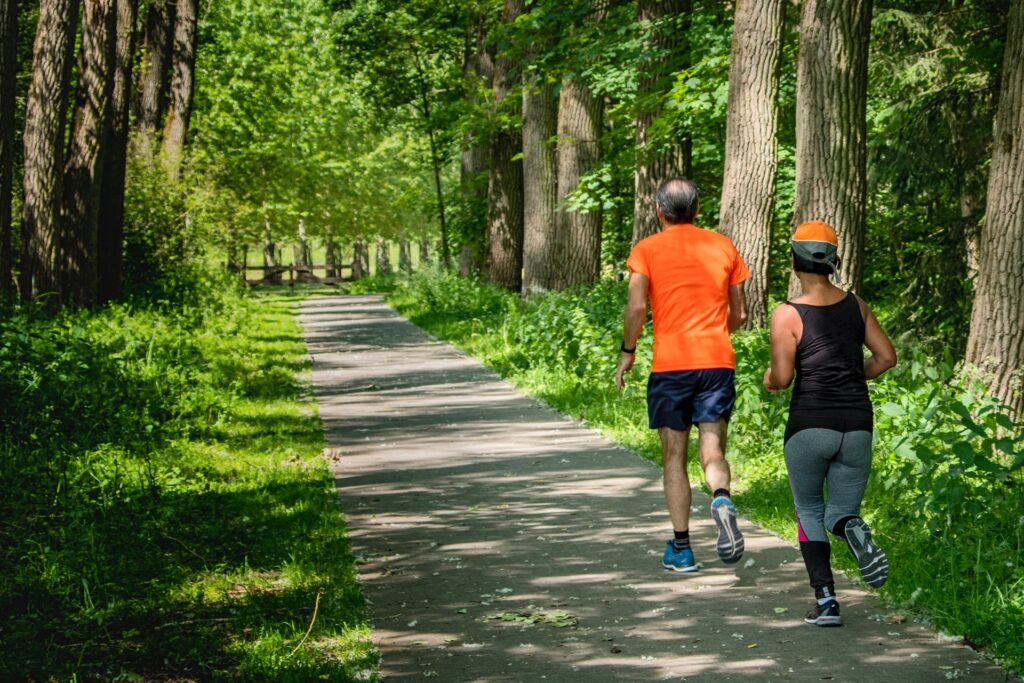
Warm up for 5 Minutes
Jog in place for 1 Minute
Make sure you’re lifting your knees high as you jog.
Do Punching for 1 Minute
Twist your body side to side as you punch to help stretch out the muscles. Make sure to keep the core tight and the fists clenched with each punch. Switch smoothly from left to right, allowing your feet to make minimal movements as you twist.
Perform Knee Thrusters for 1 Minute
To perform knee thrusters, you want to stand with both feet flat on the floor and wide apart. Try to keep the width slightly wider than your shoulders. Now slowly turn both legs to the right as your hips follow the movement.
You perform the thrust by lifting the left knee upwards and bending at a 90-degree angle. While doing so, the hands are clasped together and rest on the left hip.
Think of yourself as pulling a rope from the air and bringing it to your hips while simultaneously lifting one leg. Now lower yourself back into the original position and replicate the move with the other side of the body.
This is a cardio activity that’s low-intensity but works wonderfully for the body. Do as many as you can for 60 seconds.
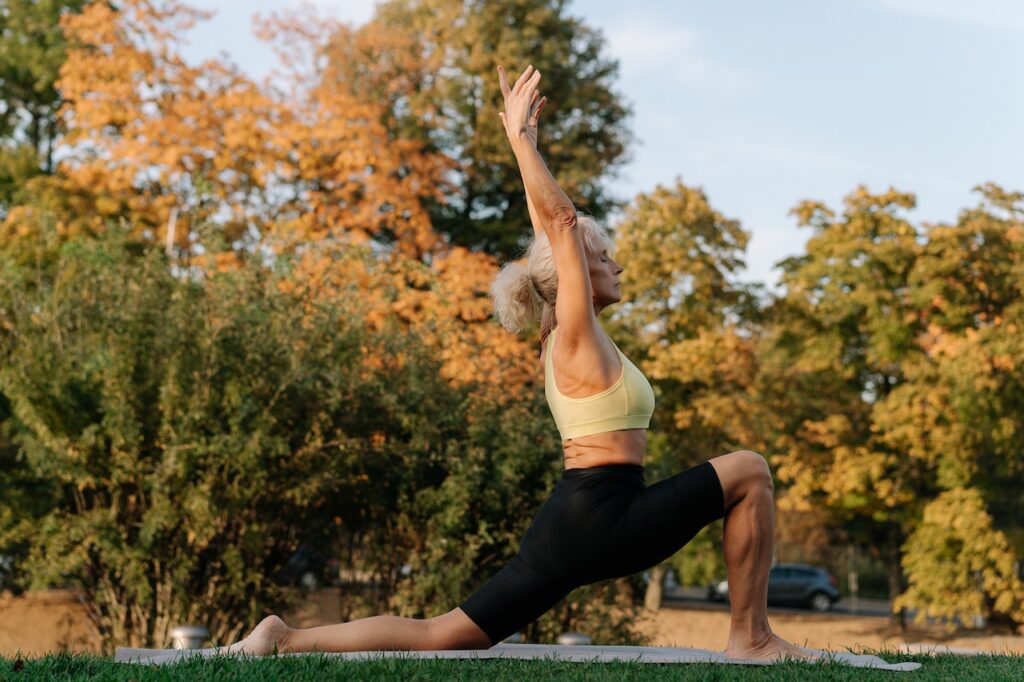
Do Basic Squats for 1 Minute
A basic squat can help develop your balance and promotes the leg muscles. To perform this activity, simply start at a standing position with your feet flat on the floor and hip-width apart. To perform the squat, just lift your arms straight forward with palms pointing outwards at shoulder height.
Bend your knees as low as you can go while keeping the spine straight. Maintain your balance with a slow descent, keeping your core intact all the time.
The goal is to bend your knees at a 90-degree angle – but you don’t have to do that yet. Instead, squat as low as you’re comfortable and then go back to your standing position. Do this for 60 seconds.
Main Workout for 15 Minutes
Once you’re done with the workout, the next step is to get into the main exercise. If you’re feeling a little winded at this point, that’s OK! You’re starting from zero and it’s perfectly fine to feel tired as your body is still adjusting.
Give yourself time to rest and prepare for the next 15 minutes. Remember that at this point, we’re just trying to fill in the 15 minutes so do as little or as much as you can within that period. No pressure!

1. Squat Curl Knee Lift
A squat curl knee lift is another low-intensity workout that helps with balance and coordination. To perform this workout, grab a pair of dumbbells with a weight that you can comfortably use. Something around 2.5 to 5 kg should do very well.
One of the best equipment for strength training at home is adjustable dumbbells, which allow you to change the weight according to your preference and ability. For variety and versatility, you can check out our review of the best adjustable dumbbells in Australia.
Holding these dumbbells in your hands, lower yourself to a squat position with your hands extended downwards and either dumbbell on the outside of your knees.
Squeeze your glutes and then slowly lift your right leg while pressing the right dumbbell to your chest. At the same time, your left leg should straighten up, allowing you to essentially balance yourself on this one leg.
Slowly lower yourself back to the squatting position and then do the exact same thing; this time with your right leg. Make sure your glutes and core are engaged each time. Do as many as you can for 60 seconds.
2. Shoulder Overhead Press
The shoulder overhead press is quick, simple, and something you can do anywhere. It doesn’t require much movement so it’s excellent strength training for seniors.
To perform the exercise, you want to start from a standing position with your feet at normal width. Grab dumbbells for each hand. Feel free to choose whatever weight you’re most comfortable in.
Slowly lift your hands to the side, your elbows bent at a 90-degree angle. Hold for a few seconds and then continue to raise it, stretching your arms up over your head. This is one repetition.
Now lower your hands down slowly and deliberately, feeling the tightness in your arms. Do this as many times as you can for 60 seconds.

3. Renegade Arm Row
The renegade arm row looks intimidating at first but there are modifications to this move that make it better for seniors. A full renegade arm row starts from a push-up position with arms stretched out and toes on the floor.
The spine should be straight. If it’s too hard, you can try the modification where you prop yourself up on your knees instead of your toes.
To perform a row, you start by lifting the right arm upwards as close to your chest as possible. Lower it, brace your hands, and then repeat the same move with your left arm.
Some people like to hold dumbbells during the exercise if they want to make things more interesting. Opt for low weights, something along the 2- or 3-kg range.
4. Bird Dog
The bird-dog exercise is all about balance. It’s a great beginner’s yoga and should help you with coordination. To perform this workout, start by going down on all fours. This is the “dog” position. Arch your back slightly and keep your head down with the neck straight forward.
To perform the “bird”, you need to lift your right arm and stretch it forward, as far as it can go. At the same time, lift and stretch your LEFT leg back so that you’re forming one straight line from the tip of your fingers following the spine and then the tips of your toes. Slowly lower back to the “dog” position and then repeat with the opposite sides of your body.
You should be able to feel a bit of instability as you try to hold the bird positions. This is perfectly normal if you’re a beginner but push on with it and you should feel your balance improve.

5. Glute Bridge
Glute bridges are essentially pelvic thrusts without the added weight. To perform this workout, you want to start in a lying position. Keep your spine flat on the floor and relaxed, with your hands on either side of you, palms down.
Now slowly bend your knees at an acute angle so that your feet are flat on the floor. At this point, your heels should be close to your butt.
To perform the “bridge”, simply lift your hips, butt, and legs upward in one smooth thrust. Most of the power of the lift should come from the butt, core, and upper legs. Do NOT brace yourself using your hands; just let them lie limply on the floor.
Each thrust is one repetition. You can do around 10 of these or as many as you can in a 60-second interval.
6. Kneeling Shoulder Tap Push-Up
This workout looks a lot like renegade arm row. Just like the row, you can modify it by bracing yourself on your knees instead of on your toes.
To perform one repetition, you simply lift one hand off the floor and tap it to the opposite shoulder. So if you raise your left hand, you should tap the right shoulder. Lower it back down and repeat with the right hand.
That’s the easy part though because this move comes with a push-up. Basically, after each tap, you want to perform a push-up by slowly and deliberately lowering your body on braced arms. Keep it slow and deliberate; you don’t want to injure yourself.
7. Mid-Back Extension
A mid-back extension is done with the help of a rolling foam. The foam is placed on the floor and you lie down on it, making sure it hits the middle of your back. From here, you just put all your weight into the foam and allow gravity to perform a bit of stretching on your behalf.
If you have no rolling foam, you can try lying down on a mat with your hand’s forearm braced on either side. From here, slowly lift your upper body and feel the stretch in your spine.

8. Full Body Sit-Up
A full-body sit-up is a variation of the popular sit-up. To do this, lie down flat on your back on the mat with your arms stretched upwards above your head.
To perform the sit-up, simply crunch yourself upwards by the core, bending your arms and legs towards the centre as if you want them to touch. Do not jerk up as this can cause more harm than good. Keep the movement controlled.
Cool Down for 5 Minutes
Congratulations! You’re done with the 15-minute exercise.
The next step is to cool down so your body can safely lower its heart rate to normal levels. The cool-down will also help prevent the buildup of lactic acid so you won’t feel sore in the morning.
Here’s what you can do.
Light Walking for 1 Minute
Never underestimate the power of a leisurely walk. Once you’re done with the workout, try walking in place for just 60 seconds. You can also take those 60 seconds to walk to the fridge and get a nice glass of water. This should help stabilise your heart rate and get you ready for what happens next.
Upper Body Stretch for 1 Minute
The next thing you do is perform a few upper-body stretches. There’s no right or wrong process here. Start with an upward stretch by simply clasping your hands together and raising your hands as high as possible above your head. Count for 10 seconds.
Still in this position, slightly bend at the hips, stretching your upper body to the left and hold this position for 10 seconds. You should be able to feel the stretch along the length of your body.
Now go back to the centre and stretch to the right for another 10 seconds. Return to the centre and then stretch forward and then backward for another 10 seconds each. For the last 10 seconds, return to the centre and stretch.

Child’s Pose for 1 Minute
The child’s pose is a yoga move that takes a little practice to do. It may seem easy because babies love to hold this position while sleeping but it requires a bit of flexibility to execute correctly. Don’t be worried if you don’t get it right the first time.
To perform a child’s pose, start by sitting down on your feet with your bottom resting on your heels. Straighten your spine and roll your shoulders a little as you stretch out your upper back. Now slowly bend your body forward, allowing your spine to slightly curve and stretch.
Stretch your arms forward as well, lifting them as far forward as your body would allow. You’re basically assuming a bowing position at this point.
Hold this position for 60 seconds, feeling the stretch along your shoulders and the upper back. Your forehead should touch the floor but if you can’t do that yet, you can put a pillow on the floor where your head can rest.
Seated Single-leg Hamstring Stretch for 1 Minute
This is a great cool-down that could give your legs a good stretch. It feels unbelievably good and should help minimise after-workout pain or soreness.
To do this stretch, just sit down on the floor with your knees folded under you. Slowly stretch out the right leg outwards and put a little bit of pressure on the top until you can feel the muscles pull.
You should be able to feel this instant relief as the tight muscles start to loosen up. Hold for 30 seconds and then switch to the other leg.
Ideally, you should be able to bend your hips and grasp the tip of your toes during this stretch. However, it’s perfectly fine if you just do a slight bend with your hips as you work on your flexibility.

Arm Swings for 1 Minute
Arm swings are performed exactly how they sound like. They’re great about you doing some arm strength training for seniors. Just stand on the floor with your feet hip-width apart and start swinging your arms back and forth in a “scissor” motion.
Your arms are creating an “X” sign as it crosses in your front chest and then swings back into a “T” as you feel the pull along your muscles. Do this for 60 seconds. You can also try to swing your arm in other directions.
What are the Effects of Elderly Strength Training?
Seeing an elderly person lifting a barbell may seem terrifying but you’ll find that the activity is helpful for their overall health. Approached properly, strength training can help seniors better navigate the health issues that usually come with age.
Numerous studies have been done to see how strength training affects senior health. Collectively, these studies have shown that there’s a positive correlation between the two.
For one thing, working out helps improve the strength levels of seniors. This is to be expected as the workout increases muscle mass. Beyond that, however, the training also works against the development of sarcopenia.

Sarcopenia is the involuntary loss of skeletal muscle mass which happens with advanced age. Simply put – strength training helps keep seniors maintain their build and posture. It also promotes endurance and can even lower blood pressure to normal levels.
Diabetic seniors can also benefit from strength training because it can reduce the body’s resistance to insulin. It can also reduce the amount of fat in the intra-abdominal area.
It’s been consistently said that muscles consume more fat, even with rest. Strength training promotes muscle mass which means that seniors can increase their resting metabolic rate with workouts. This helps deter weight gain and can reduce pressure or strain on the joints. Overall, strength training can help reduce pain and make it easier for seniors to perform day-to-day activities pain-free.
Tips to Ensure the Safety of Seniors Before Doing Strength Training
Warm Up and Cool Down Properly
You want to give yourself at least 5 minutes for the warm-up and another 5 minutes for the cool-down. Both warm-ups and cool-downs help in preventing injuries and speed up recovery after the exercise.
The cool-down can help stabilise the heart rate, stretch the muscles, and prevent the accumulation of lactic acid which is the reason for any cramping or stiffness you feel after a workout.
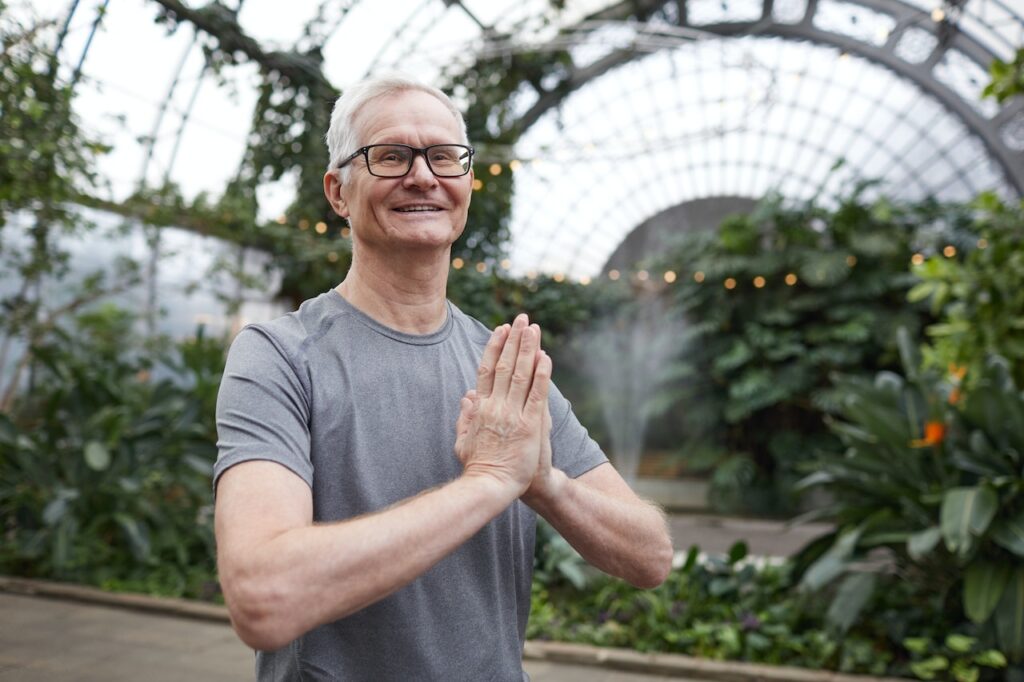
Take Your Time as You Switch From One Exercise to the Other
Remember that exercising as a senior is done for continued good health and maintenance. It’s not a HIIT workout anymore and you’re not trying to beat an unreasonable score. Hence, it’s OK to slow down and pace yourself as you switch from one workout to another.
At this stage, precision is more important than speed or power. Just the fact that you’re moving is already a big factor in your health.
Keep Yourself Hydrated
Have a convenient flask of water by your side each time. Take small sips throughout the workout – you don’t want to drink too much and feel all that water sloshing in your stomach.
When you’re done with the workout, make sure you drink a glass of water and continue to do so during the day. It helps if you have a large water container that you can use to keep track of your water consumption.
Ensure to Clear Out Your Surroundings
Always choose flat, spacious, and clean surroundings for your workout. It’s not enough that you’re standing on the mat; the mat has to be placed on solid flooring with enough space for movement.
This helps prevent injuries that can happen if you accidentally hit or smash your body against nearby items. A mat should also offer a better grip during workouts.
Wear the Appropriate Gear and Clothing
Of course, don’t forget to wear the right clothes and shoes for the exercise. You don’t need to buy workout clothes specifically; something light and form-fitting would do.
Any clothes you wear for the exercise need to be stretchable or give you a full range of motion. Avoid clothes with an extra cloth or anything hanging around you since this can easily get trapped during your workout.
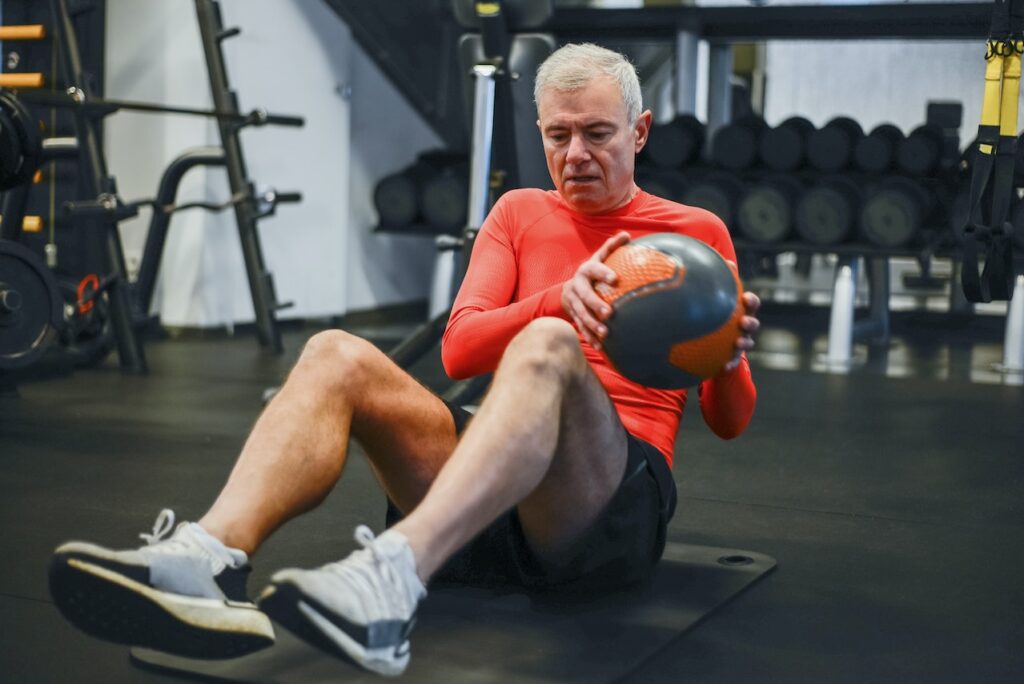
Have Plenty of Time for Rest
Set aside a generous amount of time for the workout so you don’t feel yourself running against the clock. It’s perfectly fine to rest in between sessions and give your body time to adjust. Do not push yourself too much too soon as this can lead to injuries.
Note that rest time in between workout days is also important. You’re not required to exercise daily – especially as a beginner. Allow your body to get used to the routine first before attempting more frequent workouts.
Consult Your Doctor About Your Fitness Regimen
If you have pre-existing health problems, then following the wrong fitness regimen can worsen them. That doesn’t mean you shouldn’t work out, though. It only means you need to check with your doctor before doing anything. Sticking to senior-friendly workouts is also recommended.
If you notice any problems or any symptoms emerge, inform your doctor immediately so they can provide informed feedback.
Health Benefits of Strength Training in Seniors
Improves Balance
As a person age, they start to lose their muscle strength, especially over the limb area. This is why seniors are at an increased risk of falling or tripping. Improving the strength of these muscles, specifically the lower limb and the core, can improve the balance of seniors.
Enables More Independence
Of course, with more strength comes better energy, stability, and improved mood. This paves the way for increased independence on the part of the senior.
As the muscles improve, it becomes easier for seniors to perform day-to-day activities like walking, lifting, cooking, washing, and all other daily activities. With this sense of independence, seniors feel better about themselves.
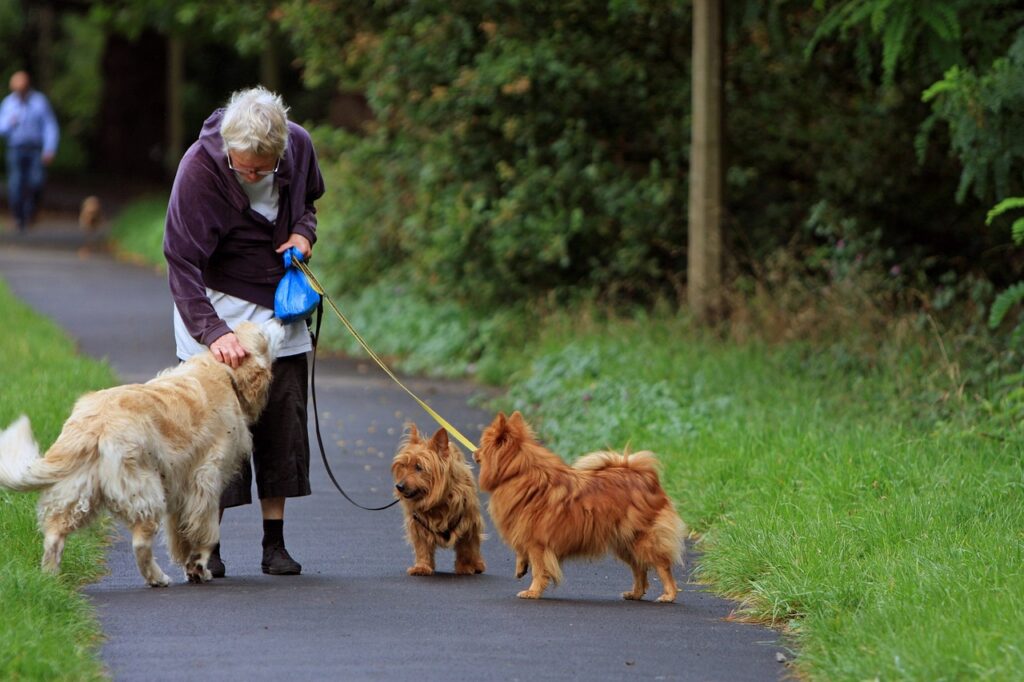
Helps Counteract Disease
Strength training has been shown to help improve the immune system. Blood circulation improves, ensuring that all body parts get the oxygen, vitamins, and minerals it needs to thrive. Strength training increases muscle mass and helps the body with posture, stability, and movement.
Plus, strength training also involves a few cardiovascular activities, which lends heavily towards organ health. As a result, different organs, especially the heart, get a good workout.
Improves Brain Function
Studies have shown that workouts can help improve the cognitive function of individuals. The same holds true even for seniors.
The improved blood circulation combined with the increase of endorphins in the body helps stabilise mood and promote focus. Done consistently over some time, strength training can help reduce the risk of Alzheimer’s or degenerative diseases of the brain.
Promotes Energy
A good workout can help boost your mood and help you feel better for the rest of the day. It has something to do with blood circulation as a workout – especially when done early in the morning – gives you an immediate “win” at the start of the day.
It gets the blood pumping and you’ll feel like the rest of the day is peanuts compared to what you already accomplished in the morning. With some exercise, people are more energetic for the rest of the day and will need less sleep come nighttime.

Final Thoughts
A 15-minute workout is just a short amount of time in the grand scheme of things but it can do wonders for overall senior health.
If you’re a beginner, there’s a good chance that 15 minutes would feel too long once you start the workout.
In this situation, it’s perfectly possible to scale back the exercise and just do 10 minutes to get you started. Any regimen is better than nothing and from there, you can improve your health day by day!
Related Questions
1. What is the safest dumbbell weight for seniors?
If you’re working out the lower body, then a 7-kilogram weight should be a good starting point. However, it’s perfectly possible to go just a tad lower if you’re starting from absolute zero. For upper body exercises, a 5 kg weight is ideal for each hand or arm exercise. Strength training for seniors is best done gradually. When in doubt, go with body weight only.
2. Are gym workouts safe for seniors?
It is fine for seniors to exercise in the gym. The added activities can help engage seniors and make them more motivated to exercise. Note that the added activity can also be stressful, especially if there are throngs of people walking back and forth in your area. If you’re working out in a gym, make sure you have a designated area. Having a coach who can assist is also highly recommended. Always consult with your physician before starting a new exercise routine.
- How Long Should You Stay in a Sauna Safely? - 20 January 2024
- Boost Post-Workout Recovery: Benefits of Using a Sauna for Recovery - 19 January 2024
- Discover the Health Benefits of a Low EMF Infrared Sauna - 19 January 2024
